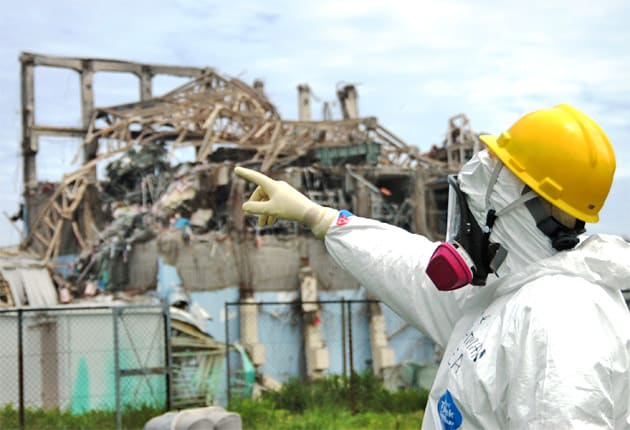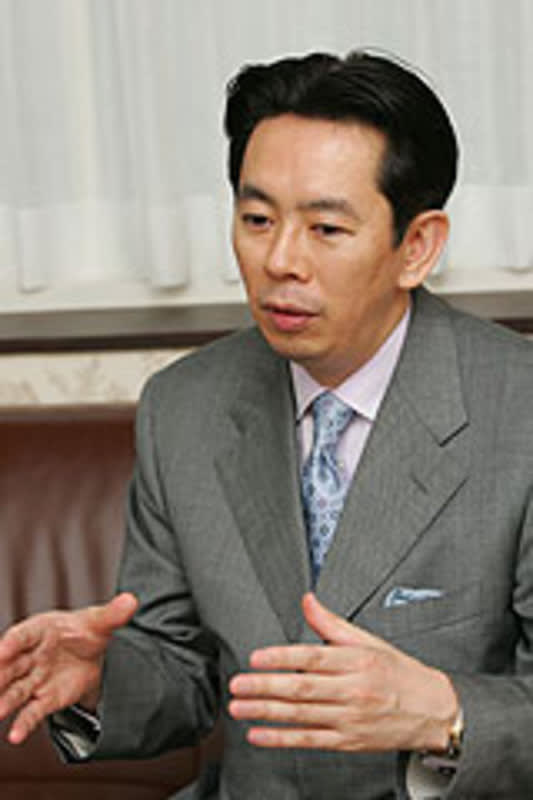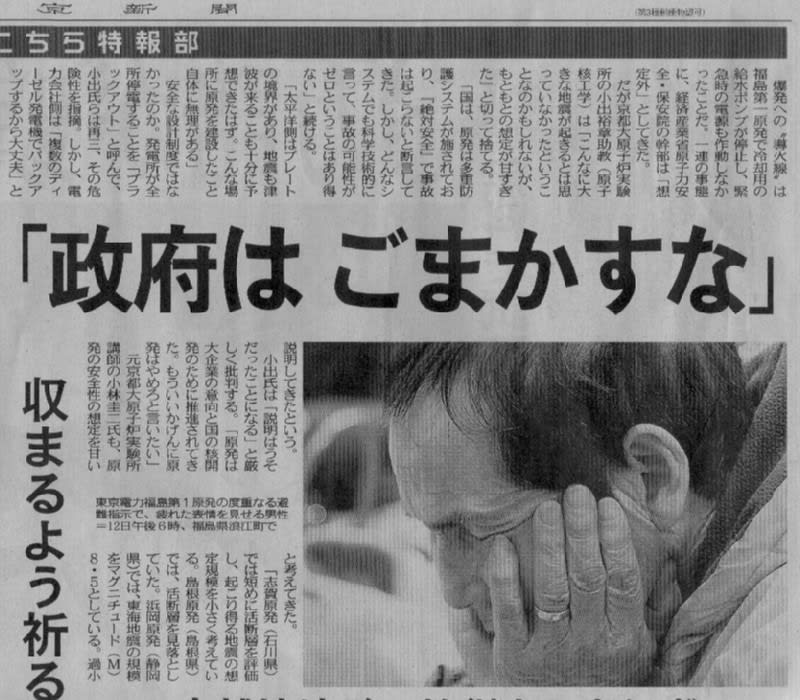【転載開始】
福島メルトダウンの背後にある衝撃的事実
日本は、原発災害は、想定外の津波と地震の組み合わせで、ひき起こされたと主張している。だが新たな証拠は、日本の原子炉は事故を起こす運命にあったことを示唆している
The Independent
David McNeill in Tokyo and Jake Adelstein
水曜日、2011年8月17日
(写真のキャプション:国際原子力機関の事実調査チームのリーダー、マイク・ウエイトマンが、事故後11週目の5月に福島第一原子力発電所の損傷を検査)
それは日本で進行中の原発事故ミステリーの一つだ。津波が襲う前に、3月11日の地震は、福島第一原子力発電所に対して、一体どれだけの損傷を与えたのだろう?
リスクは高い。もし、地震が、原発と、核燃料の安全性を、構造的に損ねたのであれば、日本中のすべての同様な原子炉を停止する必要があり得るのだ。
54基のほぼ全ての原子炉は、休止中(35基)か、あるいは、来年4月までに停止予定であり、原発再稼働に関するあらゆる論議に、構造的な安全性の問題が
のしかかっている。
この議論において、原発の運営者である東京電力と、日本政府は、とうてい信頼に足る裁定者とは言えない。3月11日後の数日間、"メルトダウンはし
ていない"と、政府のスポークスマン、枝野官房長官は繰り返した。東京電力の当時の清水正孝社長は、周知の通り、容易には信じられない発言として、後
刻、"想定外の事故だった"
と語った。事故から五ヶ月たって、枝野官房長官が話していた時点に、メルトダウンが既に起きていたことを我々は知っている。想定外どころか、事故は業界の
評論家達によって、繰り返し警告されていたのだ。
何ヶ月もの嘘と虚報の中、定着している話が一つある。地震こそが原発用の電力を損壊し、原子炉6基の冷却を止めた、というものだ。津波が、そこで
40分後に、原発の予備発電機を押し流し、あらゆる冷却を停止させ、世界で初めての三重メルトダウンを生じさせた、一連の出来事を引き起こしたのだ。
津波が施設に到達する前に、もしも再循環水配管と冷却水配管が地震の後で破裂していたらどうだろう?電力が停止する前に?建設後40年の老朽第一号炉、日本で依然稼働しているお祖父さんの古炉形に詳しい人々で、これに驚く人はまれだ。
破損して、劣化しつつある、きちんと修理されていない配管と冷却装置の問題は、長年指摘されていた。2002年9月、東京電力は、極めて重要な循環
水配管の亀裂に関するデータの隠蔽を認めた。この隠蔽を分析した、原子力資料情報室は、こう書いている。"隠蔽された記録は、再循環配管として知られてい
る原子炉の部品の亀裂に関係している。これらの配管は、原子炉から熱を取り出すために取り付けられているものだ。もしこれらの配管が破裂すれば、冷却液が
漏出する深刻な事故となる。"
3月2日、メルトダウンの9日前に、政府の監督機関、原子力安全・保安院は、再循環ポンプを含め、原発機器の極めて重要な部分の検査をしそこねてい
ることに対し、東京電力に警告した。東京電力は、検査し、必要があれば修理をし、原子力安全・保安院に、6月2日に報告するよう命じられていた。現時点で
は、その報告書は提出されていないようだ。
インデペンデント紙は、原発で何人かの作業員と話したが、皆、同じような話をくり返した。津波が襲う前に、配管と、少なくとも原子炉の一基に、深刻
な損傷が起きていた。今でも事故が起きた原発で働いていたり、関係したりしているため、全員が匿名にしてほしいと希望した。事故が起きた日に、福島原発に
いた保守技術者の作業員Aは、シューと音をたてて、洩れる配管を思い出している。
"ばらばらになる配管をこの目で見ましたし、原発中では、もっと色々壊れているだろうと思います。地震が原発内部もかなり損傷させたことに疑問の余
地はありません... 一号炉タービン建屋の壁の一部がはがれ落ちるのも見ました。あの亀裂は、原子炉に影響したかも知れません。"
原子炉壁は極めて脆弱だと、彼は言う。"炉壁が余りに堅牢だと、内部からのわずかな圧力で、ひびが入る可能性があるので、壊れやすく作られている必
要があるのです。もし内部で圧力が維持されれば...内部の機器を損傷する可能性があるので、圧力が逃げられるようになっている必要があるのです。危険な
時には、たわむように設計されているのです。そうでないと、もっとひどいことになり得ます。他の人々にとっては衝撃的かも知れませんが、我々にとっては常
識です。"
30代後半の技術者で、やはり地震の際に現場にいた作業員Bはこう回想する。"地震は二度襲ったように感じられ、最初の衝撃は余りに強く、建屋が揺れ、配
管が曲がるのが見えました。数分間のうちに、配管が破裂するのを見ました。壁からはがれ落ちるものもありました...
"誰かが、皆避難しなければだめだと叫びました。けれども、冷却水給水用配管だと思われるものを含め、何本かの配管がひび割れしているぞと言われ、
私にも見えたので、私は避難しながら、大変に心配でした。それは、冷却液が原子炉炉心に到達できないことを意味しています。もし十分な冷却液を炉心に送り
込めなければ、炉心はメルトダウンします。原子力学者でなくても、そんなことはわかります。"
車に向かって進む際に、第一原子炉の建屋の壁が崩壊し始めるのが見えた。"穴があいていました。最初の数分間、誰も津波のことは考えていませんでした。私
たちは生き残ることを考えていました。"
地震が原子炉に大きな損傷を引き起こしたという疑念は、数分後に、原発から漏れた放射能についての報告によって強化される。ブルームバーグ通信社は、午後3.29、津波が襲う前、原発からおよそ1.6キロの所で、放射能警報が鳴ったと報道している。
地震が、原子炉に対して、直接的な構造上の損傷を引き起こしたことを、当局が認めたがらない理由は明白だ。「東京電力:
帝国の暗黒」の著者、恩田勝亘氏は、こう説明している。政府や業界がそれを認めれば、"彼らが運用しているすべての原子炉の安全性にまつわる疑念が生じま
す。彼等は、同じシステム上の問題、同じ配管損傷を抱えた、多数の古めかしい原子炉を運用しているのです" 地震は、もちろん日本では日常茶飯事だ。
元原発設計者の田中三彦氏は、3月11日に起きたのは、冷却液損失事故だと説明している。"東京電力が公開したデータは、地震から数時間後の、冷却
液の膨大な喪失を示しています。これは電力喪失のせいにはできません。既に、冷却装置には大変な損傷があったので、津波が到来するずっと前から、メルトダ
ウンは不可避だったのです。"
公開されたデータは、地震直後機、午後2.52に、AとB系統両方の緊急循環冷却装置が自動的に起動したことを示していると彼は言う。"これは、冷
却液の喪失が起きた場合にのみ、起こります。"
午後3.04から3.11の間に、格納容器内部の水噴霧装置が起動した。田中氏は、これは他の冷却装置が駄目な場合にのみ、使われる緊急対策だと言う。午
後3.37頃に、津波が到来し、すべての電気系統を破壊する頃には、原発は、既にメルトダウンに向かって進んでいたのだ。
原発の現場検査を行い、東京電力のデータ改竄について、最初に内部告発をしたケイ菅岡氏は、事故が起きたことに驚いていないと語っている。日本政府
宛の、2000年6月28日付け書面で、東京電力は、原発において、ひどく損傷した蒸気乾燥機を、彼が問題を指摘してから10年間稼働し続けていると警告
した。政府は警告を二年間、放置していた。
"私はいつも単に時間の問題だと思っていました。" 事故について彼はそう語っている。"今は、自分が正しかったことが幸福と思えない、人生の一時期です。"
調査期間中、恩田氏は東京電力の原発で働いた何人かの技術者と話をした。一人は、配管が図面と合わないことがよくあったと語っていた。その場合、唯
一の解決策は、重機を使い、配管を十分近くに引き寄せ、溶接して、閉じることだ。配管の検査は、ぞんざいなことが多く、近寄りがたい配管の裏側は無視され
ることが多かった。修理作業は大急ぎで行われる。必要以上に長く、放射能に曝されたい人などいないのだ。
恩田氏はこう補足した。"福島原子力発電所を初めて訪問した際、配管の蜘蛛の巣でした。壁や天井の、地上の配管。配管を跨ぎ、配管の下をくぐって歩
かなければなりませでした。時には、頭を、配管にぶつけました。原子炉の熱を制御し、冷却液を運ぶ配管は、原子力発電所の静脈と動脈です。炉心は心臓部で
す。もし配管が破断すれば、不可欠な冷却水が炉心にまわらなくなり、心臓マヒになります。原子力の用語で、メルトダウンです。簡単に言えば、冷却液を運
び、熱を制御している配管が破裂すれば、原子炉炉心は冷却できません。冷却液が炉心に届かないのですから。"
1977年から、2009年まで東京電力に勤務し、元福島原発の安全担当者だった蓮池透氏は、"福島原発の原発事故の緊急対策には、炉心冷却のため
に海水を使うという記述はありません。海水を炉心に注入は、原子炉を破壊することです。それをする唯一の理由は、他の水や冷却液が使えない場合です。"と
語っている。
3月12日の夜明け前、原子炉の水位は急落し始め、放射能は上昇し始めた。当日午前4時過ぎに発表した東京電力の報道発表にはこうある。"格納容器
内の圧力は高いが安定している。"
発表の中には、多くの人々が見落としている一つの記述が埋もれていた。"緊急冷却水循環システムが炉心内の蒸気を冷却していた。それが機能を停止した。"
午後9.51、社長命令で、原子炉建屋内は立ち入り禁止区域となった。午後11時頃、原子炉の隣にあるタービン建屋内の放射能レベルは、一時間
0.5から1.2
mSvのレベルに達した。言い換えれば、メルトダウンは既に進行中だったのだ。このレベルだと、20分間、このレベルの放射能に曝されれば、日本の原子炉
作業員の許容量5年分を超えてしまう。
3月12日の午前4時から6時のある時点で、吉田昌郎所長は、海水を原子炉炉心に注水するべき時期だと判断し、東京電力に通知した。海水は、水素爆発が起きてから数時間後、午後8時頃まで、注水されなかった。その頃では、おそらく既に遅すぎた。
3月末、東京電力は、"福島第一原子力発電所一号機の原子炉炉心状態"という題名の報告書中で、少なくとも、こうした主張のいくつかを 多少は認める方向に進んだ。報告書には、配管を含め、重要な設備に、津波前に損傷があったとある。
"これはつまり、日本と海外の業界による、原子炉は堅牢だという保障は、吹き飛んだということです"
と、独立した放射性廃棄物コンサルタントで、グリーンピースと協力しているショーン・バーニーは語っている。"地震危険度の高い地域にあるすべての原子炉
に対し、基本的な疑問が生じます"
バーニー氏が指摘している通り、東京電力も、冷却液喪失の16時間後、第一号炉爆発の、7ないし8時間前の、大量の燃料溶融を認めている。"こうし
たこと全てを彼らは知っていたに違いありませんから、膨大な量の水で水浸しにするという彼等の決断は、太平洋への漏洩を含めて、更なる膨大な汚染を、必ず
ひき起こすものでした。"
地震によって、原発がどれほど損傷したのか、あるいは、この損傷だけが、メルトダウンの原因なのかは誰にもわからない。ただし、東京電力のデータと、目撃者の証言は、損傷がかなりのものであったことを明らかに示している。
蓮池氏はこう語っている。"東京電力と日本政府は色々説明していますが、辻褄があいません。彼等がまだ提供していない一つのことは、真実です。そうすべき頃合いです。"【転載終了】
【元記事転載】
記事原文のurl:www.independent.co.uk/news/world/asia/the-explosive-truth-behind-fukushimas-meltdown-2338819.html
Japan insists its nuclear crisis was caused by an
unforeseeable combination of tsunami and earthquake. But new evidence
suggests its reactors were doomed to fail
By David McNeill in Tokyo and Jake Adelstein
Wednesday, 17 August 2011

AP
International Atomic Energy
Agency fact-finding team leader Mike Weightman inspects the damage to
the Fukushima Daiichi nuclear power station in May, 11 weeks into the
disaster
It is one of the mysteries of Japan's
ongoing nuclear crisis: How much damage did the 11 March earthquake
inflict on the Fukushima Daiichi reactors before the tsunami hit? The stakes are high: if the earthquake
structurally compromised the plant and the safety of its nuclear fuel,
then every similar reactor in Japan may have to be shut down. With
almost all of Japan's 54 reactors either offline (in the case of 35) or
scheduled for shutdown by next April, the issue of structural safety
looms over any discussion about restarting them.
Plant
operator Tokyo Electric Power Co (Tepco) and Japan's government are
hardly reliable adjudicators in this controversy. "There has been no
meltdown," government spokesman Yukio Edano repeated in the days after
11 March. "It was an unforeseeable disaster," Tepco's then president
Masataka Shimizu famously and improbably said later. Five months since
the disaster, we now know that meltdown was already occurring as Mr
Edano spoke. And far from being unforeseeable, the disaster had been
repeatedly forewarned by industry critics.
Throughout the months of lies and misinformation,
one story has stuck: it was the earthquake that knocked out the plant's
electric power, halting cooling to its six reactors. The tsunami then
washed out the plant's back-up generators 40 minutes later, shutting
down all cooling and starting the chain of events that would cause the
world's first triple meltdown.
But what if
recirculation pipes and cooling pipes burst after the earthquake ?
before the tidal wave reached the facilities; before the electricity
went out? This would surprise few people familiar with the 40-year-old
reactor one, the grandfather of the nuclear reactors still operating in
Japan.
Problems with the fractured,
deteriorating, poorly repaired pipes and the cooling system had been
pointed out for years. In September 2002, Tepco admitted covering up
data about cracks in critical circulation pipes. In their analysis of
the cover-up, The Citizen's Nuclear Information Centre writes: "The
records that were covered up had to do with cracks in parts of the
reactor known as recirculation pipes. These pipes are there to siphon
off heat from the reactor. If these pipes were to fracture, it would
result in a serious accident in which coolant leaks out."
On
2 March, nine days before the meltdown, government watchdog the Nuclear
Industrial Safety Agency (NISA) warned Tepco on its failure to inspect
critical pieces of equipment at the plant, including recirculation
pumps. Tepco was ordered to make the inspections, perform repairs if
needed and report to NISA on 2 June. It does not appear, as of now, that
the report has been filed.
The Independent has
spoken to several workers at the plant who recite the same story:
serious damage, to piping and at least one of the reactors, occurred
before the tsunami hit. All have requested anonymity because they are
still working at or connected with the stricken plant. Worker A, a
maintenance engineer who was at the Fukushima complex on the day of the
disaster, recalls hissing, leaking pipes.
"I
personally saw pipes that had come apart and I assume that there were
many more that had been broken throughout the plant. There's no doubt
that the earthquake did a lot of damage inside the plant... I also saw
that part of the wall of the turbine building for reactor one had come
away. That crack might have affected the reactor."
The
reactor walls are quite fragile, he notes: "If the walls are too rigid,
they can crack under the slightest pressure from inside so they have to
be breakable because if the pressure is kept inside... it can damage
the equipment inside so it needs to be allowed to escape. It's designed
to give during a crisis, if not it could be worse ? that might be
shocking to others, but to us it's common sense." Worker B, a technician
in his late 30s who was also on site at the time of the earthquake,
recalls: "It felt like the earthquake hit in two waves, the first impact
was so intense you could see the building shaking, the pipes buckling,
and within minutes I saw pipes bursting. Some fell off the wall...
"Someone
yelled that we all needed to evacuate. But I was severely alarmed
because as I was leaving I was told and I could see that several pipes
had cracked open, including what I believe were cold water supply pipes.
That would mean that coolant couldn't get to the reactor core. If you
can't sufficiently get the coolant to the core, it melts down. You don't
have to have to be a nuclear scientist to figure that out." As he was
heading to his car, he could see that the walls of the reactor one
building had started to collapse. "There were holes in them. In the
first few minutes, no one was thinking about a tsunami. We were thinking
about survival."
The suspicion that the
earthquake caused severe damage to the reactors is strengthened by
reports that radiation leaked from the plant minutes later. The
Bloomberg news agency has reported that a radiation alarm went off about
a mile from the plant at 3.29pm, before the tsunami hit.
The
reason for official reluctance to admit that the earthquake did direct
structural damage to reactor one is obvious. Katsunobu Onda, author of
Tepco: The Dark Empire, explains it this way: A government or industry
admission "raises suspicions about the safety of every reactor they run.
They are using a number of antiquated reactors that have the same
systematic problems, the same wear and tear on the piping."
Earthquakes, of course, are commonplace in Japan.
Mitsuhiko
Tanaka, a former nuclear plant designer, describes what occurred on 11
March as a loss-of-coolant accident. "The data that Tepco has made
public shows a huge loss of coolant within the first few hours of the
earthquake. It can't be accounted for by the loss of electrical power.
There was already so much damage to the cooling system that a meltdown
was inevitable long before the tsunami came."
He
says the released data shows that at 2.52pm, just after the quake, the
emergency circulation equipment of both the A and B systems
automatically started up. "This only happens when there is a loss of
coolant." Between 3.04 and 3.11pm, the water sprayer inside the
containment vessel was turned on. Mr Tanaka says that it is an emergency
measure only done when other cooling systems have failed. By the time
the tsunami arrived and knocked out all the electrical systems, at about
3.37pm, the plant was already on its way to melting down.
Kei
Sugaoka, who conducted on-site inspections at the plant and was the
first to blow the whistle on Tepco's data tampering, says he was not
surprised by what happened. In a letter to the Japanese government,
dated 28 June 2000, he warned that Tepco continued to operate a severely
damaged steam dryer in the plant 10 years after he pointed out the
problem. The government sat on the warning for two years.
"I
always thought it was just a matter of time," he says of the disaster.
"This is one of those times in my life when I'm not happy I was right."
During
his research, Mr Onda spoke with several engineers who worked at the
Tepco plants. One told him that often piping would not match up to the
blueprints. In that case, the only solution was to use heavy machinery
to pull the pipes close enough together to weld them shut. Inspection of
piping was often cursory and the backs of the pipes, which were hard to
reach, were often ignored. Repair jobs were rushed; no one wanted to be
exposed to nuclear radiation longer than necessary.
Mr
Onda adds: "When I first visited the Fukushima Power Plant it was a web
of pipes. Pipes on the wall, on the ceiling, on the ground. You'd have
to walk over them, duck under them ? sometimes you'd bump your head on
them. The pipes, which regulate the heat of the reactor and carry
coolant are the veins and arteries of a nuclear power plant; the core is
the heart. If the pipes burst, vital components don't reach the heart
and thus you have a heart attack, in nuclear terms: meltdown. In simpler
terms, you can't cool a reactor core if the pipes carrying the coolant
and regulating the heat rupture ? it doesn't get to the core."
Tooru
Hasuike, a Tepco employee from 1977 until 2009 and former general
safety manager of the Fukushima plant, says: "The emergency plans for a
nuclear disaster at the Fukushima plant had no mention of using seawater
to cool the core. To pump seawater into the core is to destroy the
reactor. The only reason you'd do that is no other water or coolant was
available."
Before dawn on 12 March, the water
levels at the reactor began to plummet and the radiation began rising.
The Tepco press release published just past 4am that day states: "The
pressure within the containment vessel is high but stable." There was
one note buried in the release that many people missed: "The emergency
water circulation system was cooling the steam within the core; it has
ceased to function."
At 9.51pm, under the chief
executive's orders, the inside of the reactor building was declared a
no-entry zone. At around 11pm, radiation levels for the inside of the
turbine building, which was next door to reactor reached levels of 0.5
to 1.2 mSv per hour. In other words, the meltdown was already underway.
At those levels, if you spent 20 minutes exposed to those radiation
levels you would exceed the five-year limit for a nuclear reactor worker
in Japan.
Sometime between 4 and 6am, on 12
March, Masao Yoshida, the plant manager decided it was time to pump
seawater into the reactor core and notified Tepco. Seawater was not
pumped in until hours after a hydrogen explosion occurred, at roughly
8pm. By then, it was probably already too late.
Later
that month, Tepco went some way toward admitting at least some of these
claims in a report called "Reactor Core Status of Fukushima Daiichi
Nuclear Power Station Unit One". The report said there was pre-tsunami
damage to key facilities, including pipes.
"This
means that assurances from the industry in Japan and overseas that the
reactors were robust is now blown apart," said Shaun Burnie, an
independent nuclear waste consultant who works with Greenpeace. "It
raises fundamental questions on all reactors in high seismic risk
areas."
As Mr Burnie points out, Tepco also
admitted massive fuel melt 16 hours after loss of coolant, andseven or
eight hours before the explosion in Unit One. "Since they must have
known all this, their decision to flood with massive water volumes
would guarantee massive additional contamination ? including leaks to
the ocean."
No one knows how much damage was
done to the plant by the earthquake, or if this damage alone would
account for the meltdown. But certainly Tepco's data and eyewitness
testimony indicates that the damage was significant.
As
Mr Hasuike says: "Tepco and the government of Japan have provided many
explanations. They don't make sense. The one thing they haven't provided
is the truth. It's time they did."【元記事転載終了】












